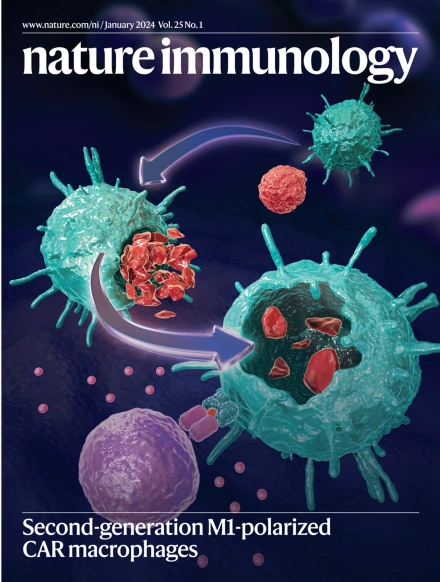Transcriptional activation of regenerative hematopoiesis via microenvironmental sensing
IF 27.7
1区 医学
Q1 IMMUNOLOGY
引用次数: 0
Abstract
Transition between activation and quiescence states in hematopoietic stem and progenitor cells (HSPCs) is tightly governed by cell-intrinsic means and microenvironmental co-adaptation. Although this balance is fundamental for lifelong hematopoiesis and immunity, the underlying molecular mechanisms remain poorly defined. Multimodal analysis divulging differential transcriptional activity between distinct HSPC states indicates the presence of Fli-1 transcription factor binding motif in activated hematopoietic stem cells. We reveal that Fli-1 activity is essential during regenerative hematopoiesis in mice. Fli-1 directs activation programs while priming cellular sensory and output machineries, enabling HSPCs co-adoptability with a stimulated vascular niche through propagation of niche-derived angiocrine Notch1 signaling. Constitutively induced Notch1 signaling is sufficient to recuperate functional hematopoietic stem cells impairments in the absence of Fli-1, without leukemic transformation. Applying FLI-1 transient modified-mRNA transduction into latent adult human mobilized HSPCs, enables their niche-mediated expansion and superior engraftment capacities. Thus, decryption of stem cell activation programs offers valuable insights for immunological regenerative medicine. Itkin et al. identify a role for Fli-1 in hematopoietic stem cell activation during regenerative hematopoiesis. They show that Fli-1 coordinates hematopoietic stem cells to stimulate niche-derived Notch1 feedback signals for demand-needed hematopoietic cell output.


通过微环境感知再生造血的转录激活
造血干细胞和祖细胞(HSPCs)在激活和静止状态之间的过渡受到细胞内在手段和微环境共同适应的严格控制。尽管这种平衡是终身造血和免疫的基础,但其潜在的分子机制仍不清楚。多模态分析揭示了不同HSPC状态之间的转录活性差异,表明在活化的造血干细胞中存在Fli-1转录因子结合基序。我们发现,在小鼠再生造血过程中,Fli-1的活性是必不可少的。Fli-1在启动细胞感觉和输出机制的同时指导激活程序,通过小生境衍生的血管分泌Notch1信号的传播,使HSPCs与受刺激的血管生态位共同适应。在缺乏Fli-1的情况下,组成性诱导的Notch1信号足以恢复功能性造血干细胞损伤,而不会发生白血病转化。将FLI-1瞬时修饰的mrna转导到潜在的成人动员的HSPCs中,使其具有小生境介导的扩展和优越的植入能力。因此,干细胞激活程序的解密为免疫再生医学提供了有价值的见解。
本文章由计算机程序翻译,如有差异,请以英文原文为准。
求助全文
约1分钟内获得全文
求助全文
来源期刊

Nature Immunology
医学-免疫学
CiteScore
40.00
自引率
2.30%
发文量
248
审稿时长
4-8 weeks
期刊介绍:
Nature Immunology is a monthly journal that publishes the highest quality research in all areas of immunology. The editorial decisions are made by a team of full-time professional editors. The journal prioritizes work that provides translational and/or fundamental insight into the workings of the immune system. It covers a wide range of topics including innate immunity and inflammation, development, immune receptors, signaling and apoptosis, antigen presentation, gene regulation and recombination, cellular and systemic immunity, vaccines, immune tolerance, autoimmunity, tumor immunology, and microbial immunopathology. In addition to publishing significant original research, Nature Immunology also includes comments, News and Views, research highlights, matters arising from readers, and reviews of the literature. The journal serves as a major conduit of top-quality information for the immunology community.
 求助内容:
求助内容: 应助结果提醒方式:
应助结果提醒方式:


